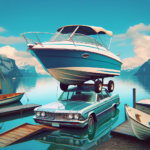When it comes to boating, safety should always be a top priority. And part of ensuring your safety on the water is being prepared for any unexpected emergencies that may arise. That’s where having a basic emergency kit on your boat becomes crucial. So, what essentials should be included in this kit? From a first aid kit to fire extinguishers, flares, and spare batteries, we’ll cover all the must-haves that will help keep you prepared and secure while out on the water.
Emergency Communication
VHF Radio
A VHF radio is an essential communication tool to have on a boat. It allows you to communicate with other boats in the vicinity, as well as with emergency services on land. In case of an emergency, having a VHF radio can be a lifesaver, as it allows for quick and efficient communication to call for help when needed. Make sure to familiarize yourself with operating the VHF radio before you set sail, so you can use it effectively if an emergency arises.
Handheld GPS
A handheld GPS device is another crucial piece of emergency communication equipment. It enables you to determine your precise location, which is essential for navigation and emergency assistance. In case of getting lost or stranded, the handheld GPS can provide accurate coordinates for search and rescue teams. This device is particularly useful when visibility is poor or when you’re in unfamiliar waters. Always ensure your handheld GPS is fully charged and consider bringing spare batteries or a power bank as a backup.
Flares
Flares are indispensable in emergency situations, as they are highly visible signals that can alert nearby boats or rescue teams to your location. There are two types of flares: handheld and aerial flares. Handheld flares emit a bright red light and can be held in your hand to signal for help. Aerial flares are launched into the air, where they produce a bright flare visible from a considerable distance. It is essential to familiarize yourself with the correct use of flares and store them in a readily accessible location on your boat.
Whistle
A whistle might seem like a small and insignificant item, but it can play a crucial role in emergency situations. A loud whistle can attract attention and serve as a distress signal. If you find yourself in a dangerous situation, blowing a whistle in short, loud bursts can alert nearby boats or individuals that you require assistance. Whistles are lightweight, easy to carry, and should be part of your emergency kit on every boating trip.
Navigation Tools
Marine Charts and Maps
Marine charts and maps are essential for safe navigation on the water. They provide detailed information about water depths, obstructions, and navigational aids. Having up-to-date charts and maps can help you navigate safely and avoid dangerous areas or unexpected obstacles. Make sure to have charts and maps specific to the area where you’ll be boating, as they will provide accurate and necessary information for your journey.
Compass
A compass is a navigation tool that helps you determine your boat’s direction relative to the Earth’s magnetic poles. It is a reliable backup to your other electronic navigation devices and doesn’t require batteries or a power source to function. In case of GPS failure or other electronic malfunctions, a compass can help you maintain your heading and navigate towards safety. Learning how to use a compass effectively is an essential skill for any boater.
Binoculars
Binoculars are indispensable tools for boaters, as they allow for enhanced visibility at a distance. Whether you’re scanning the horizon for navigation markers, identifying potential hazards, or searching for other boats or signs of distress, binoculars can greatly improve your ability to observe and assess your surroundings. Opt for waterproof and fog-proof binoculars, as they are better suited for marine environments and adverse weather conditions.
First Aid Supplies
Adhesive Bandages
Minor cuts and injuries can occur unexpectedly while on a boat. Adhesive bandages, commonly known as bandaids, are a must-have item in your first aid kit. They are useful for covering and protecting small wounds, preventing infection, and promoting faster healing. Make sure to stock your first aid kit with a variety of adhesive bandages to cater to different sizes and types of injuries.
Antiseptic Solution
An antiseptic solution, such as hydrogen peroxide or iodine-based disinfectant, is crucial for cleaning wounds and preventing infection. In a marine environment where exposure to bacteria and contaminants is higher, having an antiseptic solution in your first aid kit is essential. It can be used to cleanse cuts, scrapes, and other injuries before applying bandages or other dressings.
Gauze Pads
Gauze pads are sterile dressings that can be used to cover larger or more severe wounds. They provide a clean and absorbent surface, helping to control bleeding and protect the wound from further contamination. Gauze pads come in various sizes and thicknesses, and having a range of options in your first aid kit ensures you’re prepared for different types of injuries.
Tweezers
Tweezers are a valuable tool for removing splinters, thorns, or other foreign objects lodged in the skin. In a boating environment, where you may encounter various materials and vegetation, having a pair of tweezers in your first aid kit can help prevent infections and relieve discomfort. Ensure your tweezers have a pointed tip, are made of stainless steel for sterilization, and are stored in a protective case to avoid injury.
Emergency Signaling Devices
Signal Mirror
A signal mirror is a simple yet effective tool for attracting attention from a distance. It is a highly reflective mirror that can reflect sunlight in a concentrated beam towards a target. By aiming the mirror’s reflection towards passing boats or aircraft, you can increase your visibility and signal for help. Signal mirrors are lightweight, compact, and should be part of every boater’s emergency kit.
Air Horn
An air horn is a loud, audible signaling device that can help attract attention in emergency situations. It emits a loud and distinct sound that can carry over long distances, alerting nearby boats or rescue teams of your presence. Air horns are often more effective than vocal shouts or whistles in terms of sound projection and can be a valuable addition to your emergency signaling devices.
Distress Flag
A distress flag is a recognizable and universally understood signal for help. It is a square flag with a black square and a ball placed above it on an orange background. Displaying this flag indicates that you are in distress and require immediate assistance. The distress flag should be flown upside down, ensuring that the black square and ball are on top. Keep a distress flag in a readily accessible location on your boat to be prepared for any emergencies.
Waterproof Lighting
Flashlights
A reliable flashlight is an essential tool for any emergency situation, especially when visibility is reduced. Look for flashlights that are waterproof, durable, and have a long battery life. LED flashlights are particularly recommended due to their energy efficiency and bright illumination. Keep extra batteries or consider using rechargeable flashlights to ensure you have a reliable light source in case of emergencies.
Extra Batteries
Having spare batteries on board is essential to ensure that your electronic devices, such as flashlights or hand-held GPS devices, remain functional in emergencies. Ensure the spare batteries are compatible with your equipment and store them in a waterproof container or bag to protect them from moisture or damage. Regularly check the expiration dates on your batteries and replace them as needed.
Waterproof LED Flares
Waterproof LED flares are a modern and safe alternative to traditional pyrotechnic flares. They are non-flammable, reusable, and emit a bright light visible from a distance. Waterproof LED flares are not only environmentally friendly but also eliminate the risks associated with traditional flares, such as accidental fires or injuries. Ensure you have a set of waterproof LED flares in your emergency kit to enhance your visibility during critical situations.
Safety Equipment
Life Jackets
Life jackets, also known as personal flotation devices (PFDs), are the most important safety equipment for boaters. They are designed to keep you afloat in case of falling overboard or if your boat capsizes. Ensure that you have enough well-fitting life jackets for every person on board your boat, and that they are readily accessible. Make sure everyone understands how to properly wear and secure their life jackets for maximum effectiveness.
Throwing Ring or Rescue Buoy
A throwing ring or rescue buoy is a buoyant and throwable device that can be used to reach a person in the water and provide aid. It is especially useful if someone is struggling to stay afloat or needs assistance to get back onboard. Throwing rings typically have a rope attached, allowing you to pull the person to safety. Having a throwing ring or rescue buoy easily accessible can be a lifesaving measure in emergency situations.
Fire Extinguisher
A fire extinguisher is a crucial safety item to have on a boat, as fires can spread quickly and pose a significant threat. Choose a marine-grade fire extinguisher that is suitable for extinguishing different types of boat fires, such as electrical, fuel, or oil fires. Ensure that your fire extinguisher is within reach and that everyone on board is familiar with its location and how to use it correctly.
Emergency Food and Water
Non-perishable Food
When it comes to emergency preparedness, having an adequate supply of non-perishable food is essential. Non-perishable food items, such as canned goods, energy bars, and dried fruits, can provide sustenance in case of extended journeys, unexpected delays, or emergency situations. Choose foods that are easy to consume, require no cooking or refrigeration, and have a long shelf life. Regularly check and rotate your emergency food supply to ensure freshness.
Bottled Water
A sufficient supply of clean drinking water is vital for boating trips, especially during emergencies or unexpected situations. Bottled water is convenient, portable, and should be stored in a cool, dry place on your boat. Ensure that you have enough water for each person on board, considering the duration of your trip and any potential emergencies. Store additional water containers or have a water purification method, such as water purification tablets, as backup options.
Water Purification Tablets
Water purification tablets are a lightweight and compact solution for treating water in emergency situations. They can neutralize or eliminate microorganisms, bacteria, and viruses that may be present in contaminated water sources. In case you run out of bottled water or need to access additional water sources, having water purification tablets in your emergency kit can provide a reliable method for making water safe to drink.
Tools and Repair Supplies
Multi-tool
A multi-tool is a versatile and compact tool that combines various functions into a single device. It typically includes features such as a knife, pliers, screwdriver, and other useful tools. Having a multi-tool on your boat can aid in minor repairs, handling various tasks, and serving as a general-purpose tool in emergency situations. Choose a durable, stainless steel multi-tool that is rust-resistant and can withstand the marine environment.
Duct Tape
Duct tape is renowned for its versatility and ability to fix a wide range of problems. It can be used for temporary repairs, securing loose items, or even patching small leaks. In emergency situations, where prompt action is necessary, duct tape can serve as a temporary solution until proper repairs can be made. Carry a roll of high-quality, waterproof duct tape in your toolbox to be prepared for any unexpected situations.
Spare Rope
Having spare rope on your boat can prove invaluable in emergency scenarios. Rope can be used for various purposes, such as towing, securing items, creating temporary moorings, or performing makeshift repairs. Choose rope that is strong, durable, and resistant to water and UV damage. Ensure that your spare rope is of sufficient length and properly coiled or stored to prevent tangles or damage over time.
Personal Protective Equipment
Sunscreen
Protecting your skin from the harmful effects of the sun is crucial when spending extended periods of time on a boat. Sunscreen with a high sun protection factor (SPF) helps to minimize the risk of sunburns and skin damage caused by prolonged sun exposure. Apply sunscreen generously and regularly, especially on exposed areas of the body, and choose a sunscreen that is suitable for water activities and offers broad-spectrum protection.
Hat
Wearing a hat can provide additional protection against sun exposure and help regulate body temperature. A wide-brimmed hat or a cap with a flap that covers the neck and ears shields you from direct sunlight and reduces the risk of sunburn. Hats made from breathable and lightweight materials, such as cotton or nylon, are ideal for boating trips as they offer comfort and adequate sun protection.
Sunglasses
Protecting your eyes from the sun’s harmful UV rays is essential for maintaining good eye health. Polarized sunglasses provide optimal protection against glare and enhance visibility on the water. They reduce eye strain and minimize the risk of sun-induced eye conditions. Look for sunglasses that offer both UV protection and polarization, and choose a style that fits securely and comfortably to ensure they stay on during boating activities.
Important Documents
Boat Registration
Keeping your boat’s registration documents onboard is essential for legal compliance and identification purposes. These documents prove that the boat is properly registered and legally owned by you. In case of an emergency or an interaction with authorities, having your boat registration readily available can help expedite processes or provide necessary information.
Proof of Ownership
Proof of ownership documents, such as bills of sale or titles, establish your rightful ownership of the boat. They provide evidence that the boat belongs to you and can be required during various situations, including emergency scenarios. Ensure that these documents are stored in a waterproof and secure container to protect them from damage or loss.
Contact Information
Having important contact information readily available on your boat can be crucial in emergency situations. This should include emergency services numbers, the contact information of local Coast Guard stations or marine police, as well as the contact details of friends or family members who can be reached in case of an emergency. Keep this information in a waterproof container or laminate it to protect it from water damage.
Preparing a basic emergency kit on your boat is a responsible and necessary step to ensure your safety and the safety of your passengers while enjoying time on the water. By including items such as emergency communication devices, navigation tools, first aid supplies, signaling devices, lighting, safety equipment, food and water provisions, tools and repair supplies, personal protective equipment, and important documents, you can be well-prepared for a variety of emergency situations. Remember to regularly check and replenish your emergency kit, familiarize yourself and your crew with the location and usage of these items, and always prioritize safety while boating.





